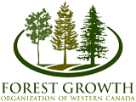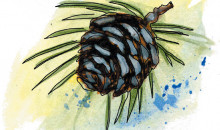After the success of FGrOW’s spring webinar series, we want to welcome you back for the latest updates on forest research.
Quick links
September 8: Long-term studies to support mixedwood management in western Canada
October 15: Bridging the gap: The Forestry Toolbox add-in for Microsoft Excel
September 8: Long-term studies to support mixedwood management in western Canada
Phil Comeau and Mike Bokalo
Download a copy of the presentation here.
Abstract
A number of long-term studies have been established in western Canada to contribute to our understanding of the dynamics and growth of mixedwood stands dominated by trembling aspen and white spruce. These studies have been designed to quantifiy effects of stand composition and effects of practices such as precommercial thinning, spot/radial herbicide application, and understory protection harvesting on tree growth and on growth and yield. In this presentation we will review several studies established in association with the Forest Growth Organization of Western Canada (FGrOW), including studies established by the Western Boreal Growth and Yield Association (WESBOGY) and the Mixedwood Management Association of Alberta (MWMA) prior to them becoming part of FGrOW. We will highlight key learnings from these studies dating back over 30 years.
Presenter Bios
Phil Comeau was Professor of Silviculture and Stand Dynamics at the University of Alberta from 2000 to 2017 and is now Professor Emeritus. Phil has conducted research relating to silviculture and growth and yield in western Canada with a major focus on evaluating and quantifying effects of spot, patch and broadcast treatments in boreal mixedwood stands on tree growth, stand yield, stand structure, biodiversity and drought resilience. Phil has been the chair of the Western Boreal Growth and Yield (WESBOGY) project team since 2003 and has worked on development of several of the component functions used in the current version of the Mixedwood Growth Model (MGM21). He received of the CIF (Canadian Institute of Forestry) Tree of Life Award (Rocky Mountain Section) in 2014 and the CIF Scientific Achievement Award in 2016.
Mike Bokalo has been the WESBOGY Research Scientist since 2001, working as a Research Assistant Professor at the University of Alberta. His work has focused on the WESBOGY Long-Term Study, including data management, data analysis and reporting. In addition, Mike has led development of the Mixedwood Growth Model (MGM) since 2005, has supported the use and application of MGM in forest management planning and yield curve development. He has also conducted studies exploring the applications of remote sensing in the measurement of mixedwood stands. Mike taught Forest Measurements from 2007 to 2020 receiving several teaching awards.
September 10: A Review of Past Efforts to Model Forest Regeneration and the Potential for Developing a Mixedwood Regeneration Model for Alberta
Robert Froese
Abstract
Regeneration models predict the presence, abundance and characteristics of small trees that are established following disturbance. A review of the worldwide literature reveals a long history of modelling forest regeneration. Regeneration models have often been built purely for research purposes, but many were designed to help understand how treatments meet reforestation objectives and/or to feed into growth and yield models in order to make long-term projections. Because regeneration is one of the most stochastic elements in forest development, success depends on good data that represent the species, subregions, and treatments of interest to model users. There have been past successes in Alberta, notably the recently released FRIPSY21 regeneration model for lodgepole pine. A surprising amount of data are available in Alberta that would be suitable for building a model for mixedwood stands but applicability would vary depending on model needs and intended architecture. There are specific challenges to modelling regeneration in mixedwoods, most notably, the differences in regeneration strategies among species and impacts of silviculture interventions. In this presentation a review of modelling concepts, applications, and a roadmap for a mixedwood model developed is shared, and feedback welcomed on future opportunities.
Presenter Bio
Robert Froese is currently the first Endowed Chair in Forest Growth and Yield at the University of Alberta. He is a Certified Forester with the Society of American Foresters and remains a Registered Professional Forester in British Columbia. Robert grew up in Vancouver, British Columbia near the gates of the University of British Columbia, surrounded by the forests of Pacific Spirit Park. He has always been drawn to forests, and believes in the importance of knowledge in informing decisions people make about their place in the natural world. Robert is committed to the role that universities can have in promoting wide general good, through professional excellence, creative scholarship, and a sincere dedication to learning. This commitment has been shaped by his academic and professional experiences in British Columbia, Idaho, Michigan, and more recently in Alberta, and was the foundation of Robert’s work in forest biometrics, modelling, and growth and yield in his previous position at Michigan Technological University.
October 15: Bridging the gap: The Forestry Toolbox add-in for Microsoft Excel
Abstract
Forestry has progressively become more quantitative over the past 20 years. Advancements in technology combined with large amounts of data, sophisticated modeling techniques and an ever-increasing level of details tracked in regulatory processes, require today’s forestry professionals to possess a complex technical knowledge and understanding. With the support of FGrOW, we developed a ‘Forestry Toolbox’ in Microsoft (R) Excel (R) that extends the complex technical knowledge and functions that forestry professionals will find useful. The Toolbox provide seamless access to several forestry models and functions while hiding all the complexity in the background. While “Green side up!” clearly no longer cuts it, we should strive for standardization and simplification of processes whenever possible. This will allow foresters to focus on what they do best while still providing access to technology and models to support decision making in contribution to the betterment of Alberta’s forests.
Presenter Bio
Gyula completed his Master’s degree in Forest Management at the University of British Columbia and holds a Forest Engineering degree from the University of Sopron in Hungary. He has been working in Alberta in the area of Growth and Yield for the past 25 years and has been involved in the development of numerous Forest Management Plans in the Province. In addition to forestry projects, Gyula has developed Microsoft (R) Excel (R) solutions for clients globally including a small police station in Brazil to teams of researchers in Antarctica.
Get the tool here.
December 17: Making the most from high-resolution imagery and LiDAR: a look to the future from an operational to strategic perspective in Alberta
John Nash
Abstract
The Alberta Vegetation Inventory (AVI) is a photo-based digital inventory developed to identify the type, extent and conditions of vegetation, where it exists and what changes are occurring. The AVI is updated every 10 years and most FMAs’ in Alberta are now covered by a ‘softcopy’ vegetation inventory (AVI). The softcopy approach represented a technological revolution as it enabled high-resolution aerial photography to be delineated and interpreted at scales not previously imaginable. Sundre Forest Products (SFP) sees the potential to use more recent imagery and Lidar data to build a more efficient inventory process. This new approach aims to consolidate the operational and strategic aspects of an inventory in a much shorter time-period potentially decreasing the interval between inventories (i.e., real-time AVI). In addition, recently acquired high resolution remotely sensed data, such as LiDAR, provides opportunities to leverage several value-added products. In this presentation we will present our views and planned approach to generate SFP’s next AVI. We will also present key value-added products we are developing to enhance our operational and strategic understanding of the current forest-state in our FMA.
Presenter Bio
John Nash has a B.A. (Environmental Studies) and B.Sc. (Biology), both from the University of Winnipeg. John has been working as a forest ecologist for 25 years, mainly with Greenlink Forestry where he provides solutions to the forestry industry from the operational to the strategic (landscape) scale. He is a self-described ‘jack-of-all-trades’ who thrives in the multi-discipline nature of forestry and ecology.
Leo Fagnan has a bilingual BSC from the Faculté St Jean and a BSC in Forestry, both from the U of A. He has 30 years of broad industrial forestry experience focusing mostly on operational planning in the Foothills. Leo enjoys integrating the best possible data acquisition methods and field knowledge, into innovative practical management processes. He is currently the planning superintendent at Sundre Forest Products.










